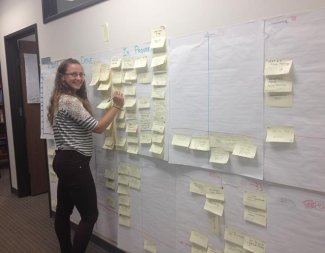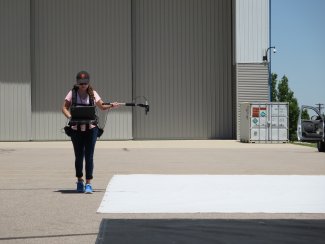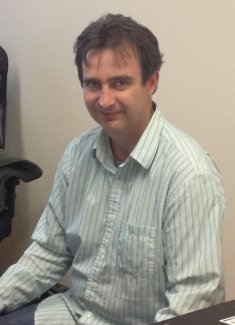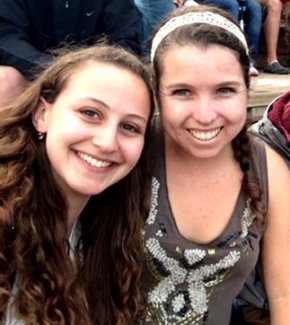Interns Summer in Review, Part 4: So, what do YOU do?
October 17, 2014
An Explanation of NEON’s Airborne Observation Platform and Cyber Infrastructure through New Eyes
By Ariel Kaluzhny and Madeleine Ball
After spending time together in NEON’s summer internship program, Ariel Kaluzhny (a computer science student) and Maddy Ball (an environmental science major) learned a lot about their NEON projects, explored a good bit of Colorado and became great friends. But, coming from such different perspectives, what they didn’t know was what their new friend did every day at NEON. So they got together and decided it was time to learn a little about each other’s departments.
This blog is about their quest. To start, they wrote first impressions of each other’s department based solely on prior knowledge from time spent together outside the office. Next, they interviewed each other and each other’s mentor. Finally, they shadowed each other to see first-hand what they did day-to-day. After all this, they sat down again and wrote their stories. Enjoy!
Student Profiles
Ariel Kaluzhny
Cyber Infrastructure Intern
School/Year: Wesleyan University, Class of 2016
Major: Computer Science and Economics
Hometown: Newton, MA
Why NEON: NEON’s description of the internship program seemed like a really good fit for me. It is geared towards students going into their junior or senior years of college and puts an emphasis on learning, which is really important to me in my first internship. Since NEON partners with other internship programs it has been so easy to meet new people and make friends. And then there’s the fact that it’s in Boulder!!
Ariel’s First Impressions of A.O.P: From what I have gathered, the Airborne Observation Platform (AOP) department collects data on a large scale by flying planes over NEON sites across the United States. They collect LiDAR data, and I know that Maddy uses a program called ENVI in order to examine or analyze image data. She’s basically “looking at pretty pictures all day.”
Madeleine (Maddy) Ball
Airborne Observation Platform Intern
School/Year: Tufts University, Class of 2015
Major: Environmental Science and Earth and Ocean Sciences
Hometown: Mill Valley, California
Why NEON: I wanted a summer internship where I could pursue my passion for science and the outdoors while learning and exploring career options. NEON has provided all that and so much more. I am gaining skills in remote sensing, learning about the monumental task NEON is taking on throughout the country, making connections… and having some fun on the side!
Maddy’s First Impressions of C.I.: I think Cyber Infrastructure takes all the data that other teams collect and does things to make it more accessible to the public. I know it involves “writing code” because that’s what Ariel talks about all the time. Beyond that, I’m not sure…

Intern Ariel Kaluzhny with agile board
Interviews of Each Other
Maddy: What are the overall goals of your department?
Ariel: The goal of Cyber Infrastructure (CI) is to create NEON’s website and data portal. This means the team is in charge of converting all of the data collected across the observatory into something that will be useful to the scientific community. They are also trying to make it so that, once NEON’s construction phase is complete, data can be converted and available through the data portal in real time.
Maddy: Within your department, what team are you on?
Ariel: I am on a team called the Data Processing Management Service (DPMS). We are in charge of converting raw data from the field into higher level data products that can be used by outside scientists, and students. DPMS implements Algorithm Theoretical Basis Documents (ATBDs) provided by NEON scientists. These documents describe how to change the raw data into higher level data.
Maddy: What are you working on this summer?
Ariel: I am working on two projects this summer to help the DPMS team. DPMS is constantly working on updating and adjusting the implementation of the algorithms that transform raw data into Level 1 data. My first project is to create tools such as graphs, difference files, and summary statistics to show possible differences in outputs before and after a code change. My second project is working on implementing the algorithms for the 2D Wind anemometer.
Maddy: How have your expectations been met/not been met?
Ariel: First, I didn’t expect the CI department to be so large and to have so many different tasks and projects going at once. I also didn’t expect everyone in the department to know what everyone else is doing, which is part of a new process the CI department is using called Agile. Every morning there is a short “Stand-Up” meeting during which everyone quickly shares what they worked on the day before, what they will work on that day, and whether they are blocked in some way. It has been nice to see the department together and aware of all the different projects within the team.
Maddy: Sketch out a day in the life of a CI Intern.
Ariel: My daily schedule usually goes like this:
8-9:30: Make sure that what I worked on the day before is correct and finished so that I can confidently speak at the Stand-Up.
9:30-10: Stand-Up Meeting
10-5: Spend time at my computer working on writing and testing code or documenting what I have done.
And of course, I have lunch with Maddy at noon every day!
Maddy: Do you have a fun story from your department?
Ariel: One day at our daily stand-up meeting, someone was asked how his meeting with the science group went. His response was that they basically wanted him to draw 7 transparent perpendicular lines in blue ink; everyone in the department simultaneously started chuckling. Although it sounded weird, I got the reference - it was a line from a comedy show from a while back. It was endearing to see all of these different people understand and appreciate this obscure comedy reference. It also really made me feel like a member of the group.

Maddy Ball measures tarp reflectance for use in airborne spectrometer calibration.
Ariel: What are the overall goals of your department?
Maddy: The overall goal of the Airborne Observation Platform (AOP) is to collect and provide aerial data that is calibrated and consistent over a large scale. AOP will fly over all NEON sites once a year with airplanes equipped with LiDAR, spectrometers, digital cameras, and a GPS/IMU. The team works together to calibrate devices, atmospherically correct images, and ultimately provide data that is easily accessible and free to the public.
Ariel: Within your department, what team are you on?
Maddy: Unlike CI, the AOP teams are less defined. There is the flight operations team, which is responsible for running all equipment on the plane, but beyond that, my sense is that each person contributes something to the overall department goal.
Ariel: What are you working on this summer?
Maddy: I'm looking at data AOP collected in June 2013 from Domain 17, the Pacific Southwest. The images cover the San Joaquin Experimental Range (see the picture at right) near Fresno, California. I am using data collected from our airplane, from AVIRIS (another hyperspectral sensor), and from Landsat (a well-known satellite) to create normalized difference vegetation indices (NDVIs) of the area. NDVIs show the distribution and concentration of vegetation in any given location. I will compare outputs from each sensor to show future data users how NEON data compares to these other well-known and trusted sensors.
Ariel: How have your expectations been met/not been met?
Maddy: Coming into this program, I wasn’t quite sure what to expect. Though I did already have some experience working with hyperspectral imagery, I had never applied it in a formal work setting. I expected to work independently and problem-solve on my own. In that sense, my expectations have been met because every day seems to bring a new challenge. I spend a lot of my time looking at images on a computer which also aligns closely with what I expected. I expected to be in the office every single day so one of the biggest surprises was how much time I got to spend in the field collecting ground data and collecting calibration data. That has been fun as well!
Ariel: Sketch out a day in the life of an AOP Intern.
Maddy: Most days start off the same way. I come in, check my emails, and pour myself a steaming cup o’ joe. From there, it really depends on the day. Some days, I have meetings to attend. Other days, I work in ENVI playing around with NEON data. I spent one day at the airplane hangar working to collect ground support data for the flight operators. The bottom line is, every day in the life of an AOP intern is a little different…which I love!
Ariel: Do you have a fun story from your department?
Maddy: It’s a pretty fun department so it’s tough to choose one. I guess one that I found pretty cool is our department’s use of coconut oil…. No we don’t suntan or make granola in AOP! We use coconut oil in our spectrometer – for cooling! – due to its special temperature properties. It’s a method thought of and designed by our AOP engineers.
Interviews with Mentors

NEON's Software Applications Team Leader, Francois Pradeau
Francois Pradeau
Team Leader, Software Applications Engineer (Ariel's Mentor)
How would you describe CI?
CI is many different things and that is why it is hard to describe in one sentence. I will break it down into our deliverables. We contribute data products, websites, and support for the observatory in many things such as monitoring assets.
What is your role within CI?
I am the team lead for the CI group in charge of generating higher-level data products (DPMS) from the raw data.
What do you like about working at NEON?
What I like most is the diversity of the science, the scientists, and the people I work with. I didn’t always have that and it is just awesome to one day sit down with someone working with small mammals and another day with someone working on AOP.
What is something unique about the department?
The diversity of our people: we have scientific programmers, website designers, people in Maximo, PDA people, and more. We really are this microcosm of almost all the software out there.
How did you get in to this field?
To me, mathematics is the Holy Grail. But, you can’t make a career out of that so I looked in to computer science and I loved it. My work is problem solving, which I find very cool.
If CI were a food, what would it be and why?
I am French, so of course I will choose something French (laughs). I would choose Boeuf Bourguignon which is a sort of meat in wine dish. It is CI because it is hearty, not light, and, oh what’s the word…dependable!
Nathan Leisso
AOP Calibration Scientist (Maddy's Mentor)
How would you describe AOP?
AOP provides a unique ability because of its scaling aspect. Most of NEON’s data is spatially fixed in place, and data from NASA is global, so AOP data fits in between those two. AOP provides a higher resolution data set which takes point measurements and then scales them higher.
What is your role within AOP?
I mostly work with calibrating the spectrometer. I also support fieldwork collected for vicarious calibration of the spectrometer and some fieldwork in support of our Level 1 and Level 2 data. Level 1 data are geo-located and atmospherically corrected while Level 2 data are derived products.
What do like about working at NEON?
Well, I came to NEON when AOP was still a small group so I got to do all of the different things that are part of our AOP mission. I also like getting to work and interact with so many different types of people.
What is something unique about the department?
The cool thing about our data sets is that we have both LiDAR and spectrometer data whereas historic hyperspectral sensors like AVIRIS only collect spectroscopic data.
If AOP were a food, what would it be and why?
(laughs) Lasagna. Because we have many layers.

NEON interns Ariel Kaluzhny and Madeleine Ball
Final Impressions from Ariel and Maddy
Ariel’s Final Impressions of AOP: Coming into my internship at NEON, I knew nothing about LiDAR, image processing, or even about the idea of using images taken from planes to study ecological change, so I have really learned a lot hanging out with Maddy and her department. Now I understand that AOP is important to NEON because it provides a completely different type of data. Their data is not spatially fixed like other types of data collected at NEON and can provide a very different insight into ecological change. They also have extensive calibration methods to ensure that the data they collect is valid and useful.
I can now see that AOP is not just flying planes and taking pretty pictures; they provide integral data that can lead to new insights and they complement and extend the data from other departments. Plus, their data is the hardest to process so they give my folks (the CI Team) a challenge!
Ariel’s Final Impressions of her own department - CI: CI is a unique department at NEON because it isn’t actually providing its own data, but it is making the data collected from a national observatory available to the scientific community. Without CI, NEON’s goal of providing long-term ecological data to the scientific community would be impossible. By working with every department to meet NEON’s goal, CI embodies the age-old saying: “the whole is greater than the sum of its parts”.
Maddy’s Final Impressions of CI: After spending time with Ariel and other members of Cyber Infrastructure, the importance of CI is abundantly clear. My initial impressions of Ariel’s role to just “code” things were not entirely wrong, but they were an extreme understatement. Not only is CI responsible for coding software we employ, they are really the “final portal” through which ALL the collected data runs. They are the ones making it possible for people to actually make use of what we are collecting.
Another thing I find inspiring is CI’s modus operandi, so to speak. I spent a morning with Ariel at what they call a “stand-up.” This is a quick, 20-minute meeting they have every morning. Each week, a different person leads it and directs everyone to explain what they did the previous day, any challenges they faced, and future directions anticipated. They all stand in front of a board of post–its with tasks written on each. When a project is completed, it is moved to the “done” board. This visual representation of how everyone is working together both ensures no task is being unnecessarily duplicated and allows others to provide assistance when necessary. This method of collaboration, particularly considering the diversity of programmers, is genius. For a field pegged as “anti-social,” they demonstrate some of the best team work I have ever witnessed.
Cyber Infrastructure, in my opinion, holds some of NEON’s greatest unsung heroes. They are absolutely vital to the NEON Project.
Maddy’s Final Impressions of her department - AOP: AOP provides a unique data set: it collects both LiDAR and hyperspectral images of all the NEON sites. Though integral to the overall NEON mission, without the support of other departments (such as CI), it could not be successful. Working with AOP has taught me innumerable skills in image processing, sensor calibration, and teamwork. Experiencing Ariel’s work in CI has complimented everything I’ve learned in AOP by showing me the importance of interdisciplinary collaboration… two heads are better than one!
This is the fourth in a series of Fall blog posts written by our 2014 summer interns reflecting on their experiences at NEON.
